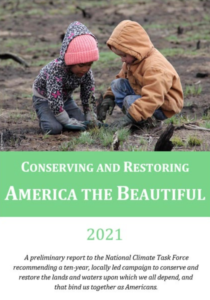By Mike Leonard

What fewer Americans realize however, is that in addition to its social and health benefits, fishing is a leading contributor to conservation. Through fishing license sales, excise taxes on equipment and direct donations, America’s 55 million anglers annually contribute $1.7 billion to conservation efforts.
So when it comes to the global initiative to conserve 30 percent of all lands and waters by the year 2030 (30 by 30), you might think recreational fishing would naturally be embraced. After all, a group that so clearly cares about and depends upon conservation should only stand to benefit from such an effort, right?
As is often the case when it comes to fish and wildlife policy, it’s complicated. In this case, the challenge largely comes down to how the term “conservation” is defined.
Recreational fishermen view their pastime as completely compatible with conservation. While relatively light, fishing does have an impact on the resource. But thanks to a robust fisheries management system, largely funded by anglers, fishing is well-regulated and U.S. fish stocks are healthy.
However, in natural resource policy, an alternative view of “conservation” is often promoted, one which is actually truer to the term “preservation.” This approach is more restrictive and hands-off, preferring to lock areas away from the public.
These divergent approaches to fish and wildlife management are currently on display as 30 by 30 is playing out in the U.S., even in two administrations of the same party.
In January 2021, President Biden signed Executive Order 14008, which called for a report from relevant federal agencies on steps the U.S. should take to achieve the 30 by 30 goal.
 The recreational fishing community breathed a sigh of relief when the report came out in May 2021. The report was notable not only for its incorporation of many positive strategies for how 30 by 30 should be implemented, including its emphasis on increasing access for outdoor recreation, but also for what it avoided, specifically by not recommending the pursuit of marine protected areas (MPAs) in which recreational fishing might be banned without a scientific basis. The report also began a rebranding of 30 by 30 as the “America the Beautiful” initiative.
The recreational fishing community breathed a sigh of relief when the report came out in May 2021. The report was notable not only for its incorporation of many positive strategies for how 30 by 30 should be implemented, including its emphasis on increasing access for outdoor recreation, but also for what it avoided, specifically by not recommending the pursuit of marine protected areas (MPAs) in which recreational fishing might be banned without a scientific basis. The report also began a rebranding of 30 by 30 as the “America the Beautiful” initiative.
The Biden Administration has provided continual evidence that it is staying true to its commitment. Actions like expanding fishing access at National Wildlife Refuges, providing a record amount of Wildlife and Sport Fish Restoration funds to the states, and proposing new National Marine Sanctuaries in which sportfishing is allowed have all been done under “America the Beautiful,” and all are in line with the true definition of conservation.
And then we have California.
Months after President Biden’s executive order, Gov. Newsom issued an executive order of his own that similarly established the 30 by 30 goal and called for a report from the California Natural Resources Agency (CNRA) and other relevant agencies to develop a strategy for how to get there.
Unlike the Biden Administration, California’s draft 30 by 30 strategy ignores the importance of recreational fishing and has put the community on the defensive.
 The draft strategy claims that MPAs are the singular management approach that conserves marine biodiversity. Because 16 percent of state marine waters are currently part of the MPA network, this means California would need to nearly double the amount of no fishing zones to meet the 30 by 30 goal!
The draft strategy claims that MPAs are the singular management approach that conserves marine biodiversity. Because 16 percent of state marine waters are currently part of the MPA network, this means California would need to nearly double the amount of no fishing zones to meet the 30 by 30 goal!
By only counting the state MPA network, CNRA is ignoring a wide range of current conservation measures, such as National Marine Sanctuaries and gear restricted areas, that protect and restore biodiversity.
Also, this approach contradicts the “expand equitable outdoor access and recreation for all Californians” goal of Gov. Newsom’s Executive Order. Sportfishing is one of the best ways for minority communities to engage in the outdoors. In 2020, recreational fishing was more popular and diverse than ever before.
Hopefully by seeing the success and support of the Biden approach, and by recognizing the wide body of science that shows MPAs are not the only way to achieve biodiversity protection, California will redirect its approach to look more like President Biden’s America the Beautiful initiative.
If 30 by 30 is to have success in California, the state must broaden beyond its MPA network and consider the many additional management approaches that will achieve biodiversity goals while simultaneously expanding equitable outdoor access and recreation for all Californians.
Mike Leonard is the vice president of Government Affairs for the American Sportfishing Association, the trade association representing the recreational fishing industry
Share This Article, Choose Your Platform:
Recent Posts


